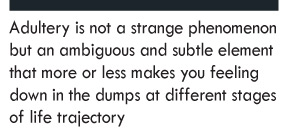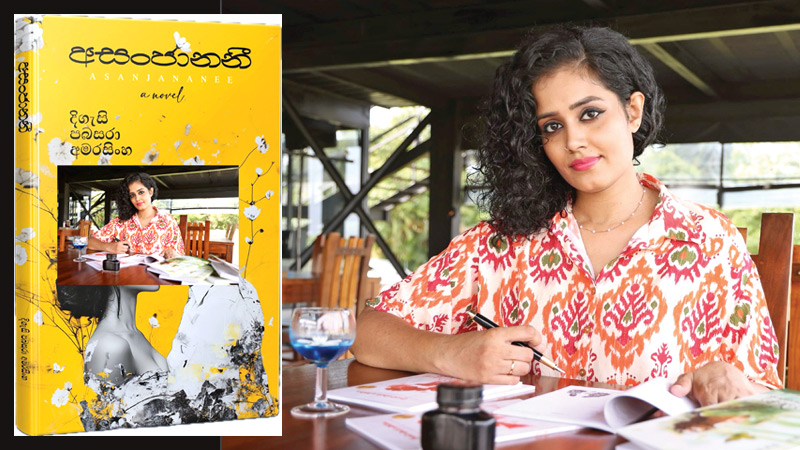With a vigorously evocative portrayal, Digesi Pabasara Amarasingha gets the ball rolling by penning ‘Asanjananee’, her second fiction within nearly two years, following the debut ‘Nuwaraka Senehasa’.
 Digesi is a masterful writer with several published anthologies to her credit. Initially set in the island’s Southern Province with predominant occurrences flowing centrally through its capital, Asanjananee unfolds a fascinating story of which essence and insight may manifest a synonym for fictions, surrounded by adultery and recovery.
Digesi is a masterful writer with several published anthologies to her credit. Initially set in the island’s Southern Province with predominant occurrences flowing centrally through its capital, Asanjananee unfolds a fascinating story of which essence and insight may manifest a synonym for fictions, surrounded by adultery and recovery.
Adultery is not a strange phenomenon but an ambiguous and subtle element that more or less makes you feeling down in the dumps at different stages of life trajectory.
 Sanjana and Jithendra, the dual protagonists of the story, represent the society’s upper crust; the duo are above the salt. Despite Sanjana and Devin being head over heels with each other, their school time romance was forced to perish; gaining the consent of their parents for the nuptials was far remote.
Sanjana and Jithendra, the dual protagonists of the story, represent the society’s upper crust; the duo are above the salt. Despite Sanjana and Devin being head over heels with each other, their school time romance was forced to perish; gaining the consent of their parents for the nuptials was far remote.
Meanwhile, Sanjana weds Jithendra, a son of a friend of Sanjana’s mother. Following the marriage, Sanjana bids adieu to her hometown Galle and leaves for Colombo. Sanjana’s chum Aseni is her Maid of Honour whilst Jithendra’s most trusted lieutenant Rahal becomes his best man at their nuptial ceremony.
The meeting between Aseni and Rahal makes them lovers whilst both eventually tie the nuptial knot. Both couples chose to share the same quarters facilitated by their place of work; however, a relatively small amount is added on the rental.
Accidental meeting
Amidst these matters of trivial significance, on a certain day, an individual named Kevin happens to come to the place where Sanjana and Jithendra work. A bash, organised for year-end celebrations, creates the platform for the accidental meeting of Sanjana and Kevin. To her utter astonishment, Sanjana finds that Kevin shows an intense interest in her; his enthusiasm for Sanjana is as sharp as mustard. Sanjana being rather vigilant about the currently unfolding drama also feels as if Kevin is rather dear and near to her.
Upon hearing of such an encounter, Jithendra flies off the handle; being hot under the collar, Jithendra assisted by a few of his colleagues beat up Kevin. Despite Jithendra being hysterical in sheer anger, Sanjana manages to visit the wounded Kevin who is being treated in hospital. Riding out the storm, Sanjana and Kevin keep in contact on a social media platform. These constant conversations reveal the fact that Kevin is the younger sibling of Devin, Sanjana’s old flame.
Sanjana catches the drift of Kevin. Kevin declares as to how his brother Devin is still worrying about his lost love. In the meantime, Dilki invades the story with Kevin being interested in her which paves the way for both of them falling in love with each other, despite Dilki already being married to another. Sanjana herself, cutting to the quick over Jithendra’s infidelity, resumes her romantic relationship with Devin. Dilki is green with envy over Sanjana and blows the gaff with Jithendra who becomes adamant on his divorce. Ultimately sinking into deep waters, Sanjana leaves home.
Asanjananee is a poignant tale that arouses the interest of the reader for its rich and sound plot. The fiction at the outset itself captures the reader’s collective imagination. Despite being unfaithful on many occasions, Jithendra predominantly blames Sanjana in the hopes of repudiating the severity of his actions.
A variety of literary devices are visible right throughout the story. It contains terrific prose, appearing in every inch. The writer’s knack for applying vibrant and compelling imagery is rather phenomenal.
The protagonists are naturally etched. The reader is driven with a resolute offering of reality. Widespread transparency running across the plot creates unassuming thoughts from the reader’s perspective.
The writer accentuates the catastrophic nature of infidelity as well as that of the desolation that it inflicts not only on the life of Sanjana but also on everyone who is near and dear to her. Asanjananee may also be an indirect study of “Romantic Malady” and its grave repercussions of distress and anguish faced by the relevant parties that are not either willing to or unable to sort out the battling differences and ever growing conflicts that remain in between their wildest imaginations and romanticised aspirations and the real world scenario. ‘Asanjananee’, ‘a Digesi publication, is worth occupying a concerned reader’s bookshelf.






